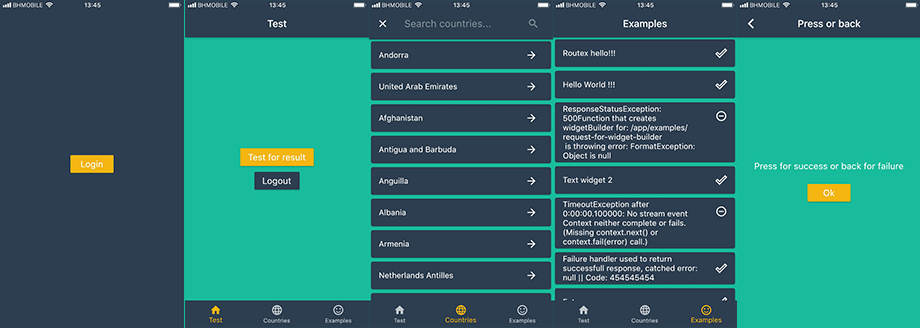routex 1.0.2  routex: ^1.0.2 copied to clipboard
routex: ^1.0.2 copied to clipboard
Identify your logic with URI, apply any number of composable asynchronous or synchronous handlers using intuitive syntax. Supports route navigation.
Example app has built in parallel with framework, and it has over 20+ examples, designed to show framework capabilities, composition, error handling, and RoutexNavigator - Routex consumer ready to use in your app.
Each snippet in this document comes from example app:

Try to notice relation between screens and code in example.dart file:
void main() => runApp(AppWidget());
void bindRouter(Router router) {
router.route("/*").handler(AppComponentHandler()); //basic app dependencies, available on app level
router
.route("/app/*") //each route that starts with /app/ requires authenthicated user, and user component for di
.handler(AuthHandler(redirectTo: "/public/login")) //redirects to /public/login if user isn't presented.
.handler((context) => context.put("sync_handler_between_two_asyncs", "Hello ${context.get<User>(User.key).name} :)").next())
.handler(UserComponentHandler()); //creates user component
router.route("/public/login").handler((context) =>
context.response().end((_) => LoginScreen(context.get<AppComponent>(AppComponent.key).setUser)));
router
.route("/app/main")
//.handler((context) => throw "Exceptions are propagated to failureHandlers or left to global error handlers.")
.handler(mainScreen)
.failureHandler((context) => context.response().end((_) =>
Text("if some exception happens you can" +
" continue contex with any number of failure handlers, you can show error screen or simply omit failureHandlers and propagate error to global error handlers.")));
var testController = TestController();
testController.bindRouter(router);
var countriesController = CountriesController();
countriesController.bindRouter(router);
var examplesController = ExamplesController();
examplesController.bindRouter(router);
//Controller is just convinient way to group related routes and handlers, it doesn't have any other purpose
// abstract class Controller {
// void bindRouter(Router router);
// }
}
//equivalent of .handler((context) => context.response().end((_) => MainScreen()))
WidgetBuilder mainScreen(RoutingContext context) => (_) => MainScreen();
class AppWidget extends StatelessWidget {
@override
Widget build(BuildContext context) {
//To support hot reload in development, use RoutexNavigator.newInstance() to ensure new instance on each reload
//otherwise just use RoutexNavigator.shared and instance will be automatically created.
bindRouter(RoutexNavigator.newInstance().router);
return MaterialApp(
debugShowCheckedModeBanner: false,
theme: AppTheme.instance,
home: RoutexNavigator.shared.get("/app/main")(context),
);
}
}
Main app content:
- Test tab shows how to start another screen for result using handler and ability to log out.
- Countries tab gives you idea how to integrate Routex in your app with other code.
- Examples tab shows usage of router directly with streams without RoutexNavigator (ExamplesController => ExamplesSource => ExamplesScreen)